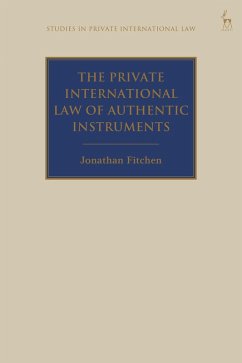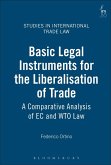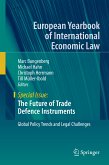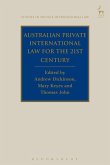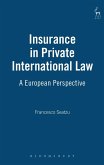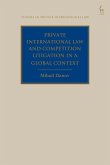Jonathan Fitchen
The Private International Law of Authentic Instruments (eBook, PDF)
42,95 €
42,95 €
inkl. MwSt.
Sofort per Download lieferbar

21 °P sammeln
42,95 €
Als Download kaufen

42,95 €
inkl. MwSt.
Sofort per Download lieferbar

21 °P sammeln
Jetzt verschenken
Alle Infos zum eBook verschenken
42,95 €
inkl. MwSt.
Sofort per Download lieferbar
Alle Infos zum eBook verschenken

21 °P sammeln
Jonathan Fitchen
The Private International Law of Authentic Instruments (eBook, PDF)
- Format: PDF
- Merkliste
- Auf die Merkliste
- Bewerten Bewerten
- Teilen
- Produkt teilen
- Produkterinnerung
- Produkterinnerung

Bitte loggen Sie sich zunächst in Ihr Kundenkonto ein oder registrieren Sie sich bei
bücher.de, um das eBook-Abo tolino select nutzen zu können.
Hier können Sie sich einloggen
Hier können Sie sich einloggen
Sie sind bereits eingeloggt. Klicken Sie auf 2. tolino select Abo, um fortzufahren.

Bitte loggen Sie sich zunächst in Ihr Kundenkonto ein oder registrieren Sie sich bei bücher.de, um das eBook-Abo tolino select nutzen zu können.
This helpful book will equip the lawyer - whether notary, barrister or solicitor - with the legal information necessary to understand what an authentic instrument is (and what it is not), what it can (and what it cannot) be used to do in the course of contentious or noncontentions legal proceedings.
The book takes a two part approach. Part one focuses on an explanation of the nature of the foreign legal concept of an authentic instrument, setting out the modes of creation, typical domestic evidentiary effects and the typical domestic options to challenge such authentic instruments. Part two…mehr
- Geräte: PC
- mit Kopierschutz
- eBook Hilfe
- Größe: 21.65MB
Andere Kunden interessierten sich auch für
![Basic Legal Instruments for the Liberalisation of Trade (eBook, PDF) Basic Legal Instruments for the Liberalisation of Trade (eBook, PDF)]() Federico OrtinoBasic Legal Instruments for the Liberalisation of Trade (eBook, PDF)135,95 €
Federico OrtinoBasic Legal Instruments for the Liberalisation of Trade (eBook, PDF)135,95 €![The Future of Trade Defence Instruments (eBook, PDF) The Future of Trade Defence Instruments (eBook, PDF)]() The Future of Trade Defence Instruments (eBook, PDF)129,95 €
The Future of Trade Defence Instruments (eBook, PDF)129,95 €![Liability for Transboundary Pollution at the Intersection of Public and Private International Law (eBook, PDF) Liability for Transboundary Pollution at the Intersection of Public and Private International Law (eBook, PDF)]() Guillaume LaganièreLiability for Transboundary Pollution at the Intersection of Public and Private International Law (eBook, PDF)35,95 €
Guillaume LaganièreLiability for Transboundary Pollution at the Intersection of Public and Private International Law (eBook, PDF)35,95 €![Australian Private International Law for the 21st Century (eBook, PDF) Australian Private International Law for the 21st Century (eBook, PDF)]() Australian Private International Law for the 21st Century (eBook, PDF)25,95 €
Australian Private International Law for the 21st Century (eBook, PDF)25,95 €![Insurance in Private International Law (eBook, PDF) Insurance in Private International Law (eBook, PDF)]() Francesco SeatzuInsurance in Private International Law (eBook, PDF)101,95 €
Francesco SeatzuInsurance in Private International Law (eBook, PDF)101,95 €![Private International Law and Competition Litigation in a Global Context (eBook, PDF) Private International Law and Competition Litigation in a Global Context (eBook, PDF)]() Mihail DanovPrivate International Law and Competition Litigation in a Global Context (eBook, PDF)80,95 €
Mihail DanovPrivate International Law and Competition Litigation in a Global Context (eBook, PDF)80,95 €![Private International Law in Nigeria (eBook, PDF) Private International Law in Nigeria (eBook, PDF)]() Chukwuma OkoliPrivate International Law in Nigeria (eBook, PDF)50,95 €
Chukwuma OkoliPrivate International Law in Nigeria (eBook, PDF)50,95 €-
-
-
This helpful book will equip the lawyer - whether notary, barrister or solicitor - with the legal information necessary to understand what an authentic instrument is (and what it is not), what it can (and what it cannot) be used to do in the course of contentious or noncontentions legal proceedings.
The book takes a two part approach. Part one focuses on an explanation of the nature of the foreign legal concept of an authentic instrument, setting out the modes of creation, typical domestic evidentiary effects and the typical domestic options to challenge such authentic instruments. Part two then examines and analyses authentic instruments under specific European Union private international law regulations, focusing on the different cross-border legal effects allowed and procedures that apply to each such.
Rigorous, authoritative and comprehensive, this will be an invaluable tool to all practitioners in the field.
The book takes a two part approach. Part one focuses on an explanation of the nature of the foreign legal concept of an authentic instrument, setting out the modes of creation, typical domestic evidentiary effects and the typical domestic options to challenge such authentic instruments. Part two then examines and analyses authentic instruments under specific European Union private international law regulations, focusing on the different cross-border legal effects allowed and procedures that apply to each such.
Rigorous, authoritative and comprehensive, this will be an invaluable tool to all practitioners in the field.
Produktdetails
- Produktdetails
- Verlag: Bloomsbury eBooks UK
- Seitenzahl: 504
- Erscheinungstermin: 26. November 2020
- Englisch
- ISBN-13: 9781509907625
- Artikelnr.: 60201537
- Verlag: Bloomsbury eBooks UK
- Seitenzahl: 504
- Erscheinungstermin: 26. November 2020
- Englisch
- ISBN-13: 9781509907625
- Artikelnr.: 60201537
- Herstellerkennzeichnung Die Herstellerinformationen sind derzeit nicht verfügbar.
Jonathan Fitchen was Professor of Law at the University of Aberdeen, UK.
Introduction
I. Matters Included
II. Matters Excluded
III. Consequences of a Lack of an EU Competence to Harmonise the Authentic
Instrument or Notarial Practice at the Domestic Level
IV. The European Rather than Global Focus of this Book
V. The French and German Legal Systems as Representative Exemplars of the
Domestic Functions and Possibilities of Notarial Authentic Instruments
VI. Brexit
VII. Order of Treatment
PART I
DOMESTIC LAWS
1. The Authentic Instrument as a Legal Institution of the Civil Law
I. The Authentic Instrument in Abstract
II. Notaries of the Civil Law and their Notarial Authentic Instruments
Considered in Abstract
III. An Outline of the Steps Usually Taken by a Notary to Draw-Up an
Authentic Instrument
IV. An Evidentiary Point: What is and is not Proven by the Authentic
Instrument?
V. Notarial Evidential Determinations in an Authentic Instrument May Allow
Immediate Enforcement
2. The Authentic Instrument in the Domestic Laws of France and Germany
I. Early Origins of Notaries and their Notarial Instruments
II. The Development of Domestic Notarial Authentic Instruments
3. The Cross-Border Legal Effect of Authentic Instruments
I. Introduction
II. An Authentic Instrument Employed Outwith the State of its Creation
III. Distinguishing between Contentious Judgments and Non-Contentious
Notarial Authentic Instruments
IV. A Preliminary Aside Concerning Judgments: Can the Contents of the
Authentic Instrument be Converted to a Judgment in the Place of Drawing-Up
and then be Exported as a Judgment?
V. Producing Private International Law Effects via Foreign Notarial
Authentic Instruments: Legalisation
VI. Regulation 2016/1191 Promoting the Free Movement of Citizens by
Simplifying the Requirements for Presenting Certain Public Documents in the
European Union and Amending Regulation (EU) No 1024/2012
VII. Producing Private International Law Effects via Foreign Notarial
Authentic Instruments: Legalisation
VIII. The Circulation of the Legal Effects of Notarial Authentic
Instruments via Domestic Civil Procedure Law
IX. The 'Reception' of Foreign Authentic Instruments 'As Such' by the
French and German Legal Systems
X. Allowing Domestic Effect Concerning the Probative Force of a Foreign
Authentic Instrument
XI. Allowing Domestic Effect Concerning the Executory Force of a Foreign
Authentic Instrument
XII. The Circulation of the Legal Effects of Notarial Authentic Instruments
via Bilateral Conventions between Founding Member States of the EEC
XIII. Conclusion
PART II
EUROPEAN PRIVATE INTERNATIONAL LAW REGULATIONS
4. Authentic Instruments in the Brussels I Family
I. Introduction
II. The Legal Requirements for a Cross-Border Notarial Authentic Instrument
that is to Circulate via a Member of the Brussels I Family of Conventions
and Regulations
III. Brussels I Family Eligibility Criteria Required for an Authentic
Instrument to be Capable of Cross-Border Circulation in the EU or EFTA
States
5. European Enforcement Order Regulation
I. Introduction
II. The Legal Requirements for the Circulation of an Authentic Instrument
via the EEO Regulation
III. What Role for the Enforcement Authorities and Courts in the
Enforcement Venue?
IV. Procedural Disadvantage of the Debtor and Issues Related to the
Regulation's Lack of Public Policy Control
V. Conclusion
6. The Maintenance Regulation
I. Introduction
II. Differences in National Perspectives on What is Meant by 'Maintenance'
III. Drafting the EC's Maintenance Regulation
IV. The Maintenance Regulation and Authentic Instruments
V. The Maintenance Regulation and Notarial Authentic Instruments,
Similarities and Differences with the Regulations Considered so Far
VI. Authentic Instruments in the Drafting of the EC Maintenance Regulation
VII. Reaching the Final Text of the Regulation Concerning Authentic
Instruments
VIII. Article 48 Court Settlements and Authentic Instruments
IX. What does Article 48(1) and the Maintenance Regulation Mean by the
'Recognition' of Authentic Instruments?
X. Article 48(2), What is Meant by 'As Necessary'?
XI. Operation of the Regulation: General Requirements
XII. Application of the Maintenance Regulation in the Context of Authentic
Instruments
XIII. Conclusion
7. The Brussels IIa Regulation
I. Introduction
II. The Limited but Developing Role of Authentic Instruments and Approved
Settlements in the Brussels II Convention and Subsequent Brussels II
Regulations
III. The Brussels IIa Regulation
IV. Proceeding to Cross-Border Recognition and/or Enforcement in the
Context of Authentic Instruments via the Recast Regulation
V. Conclusion
8. Succession Regulation, Matrimonial Property Regulation, and Registered
Partnership Property Regulation
I. Introduction
II. Authentic Instruments in the Succession Regulation
III. Matrimonial Property and Registered Property Regulations
I. Matters Included
II. Matters Excluded
III. Consequences of a Lack of an EU Competence to Harmonise the Authentic
Instrument or Notarial Practice at the Domestic Level
IV. The European Rather than Global Focus of this Book
V. The French and German Legal Systems as Representative Exemplars of the
Domestic Functions and Possibilities of Notarial Authentic Instruments
VI. Brexit
VII. Order of Treatment
PART I
DOMESTIC LAWS
1. The Authentic Instrument as a Legal Institution of the Civil Law
I. The Authentic Instrument in Abstract
II. Notaries of the Civil Law and their Notarial Authentic Instruments
Considered in Abstract
III. An Outline of the Steps Usually Taken by a Notary to Draw-Up an
Authentic Instrument
IV. An Evidentiary Point: What is and is not Proven by the Authentic
Instrument?
V. Notarial Evidential Determinations in an Authentic Instrument May Allow
Immediate Enforcement
2. The Authentic Instrument in the Domestic Laws of France and Germany
I. Early Origins of Notaries and their Notarial Instruments
II. The Development of Domestic Notarial Authentic Instruments
3. The Cross-Border Legal Effect of Authentic Instruments
I. Introduction
II. An Authentic Instrument Employed Outwith the State of its Creation
III. Distinguishing between Contentious Judgments and Non-Contentious
Notarial Authentic Instruments
IV. A Preliminary Aside Concerning Judgments: Can the Contents of the
Authentic Instrument be Converted to a Judgment in the Place of Drawing-Up
and then be Exported as a Judgment?
V. Producing Private International Law Effects via Foreign Notarial
Authentic Instruments: Legalisation
VI. Regulation 2016/1191 Promoting the Free Movement of Citizens by
Simplifying the Requirements for Presenting Certain Public Documents in the
European Union and Amending Regulation (EU) No 1024/2012
VII. Producing Private International Law Effects via Foreign Notarial
Authentic Instruments: Legalisation
VIII. The Circulation of the Legal Effects of Notarial Authentic
Instruments via Domestic Civil Procedure Law
IX. The 'Reception' of Foreign Authentic Instruments 'As Such' by the
French and German Legal Systems
X. Allowing Domestic Effect Concerning the Probative Force of a Foreign
Authentic Instrument
XI. Allowing Domestic Effect Concerning the Executory Force of a Foreign
Authentic Instrument
XII. The Circulation of the Legal Effects of Notarial Authentic Instruments
via Bilateral Conventions between Founding Member States of the EEC
XIII. Conclusion
PART II
EUROPEAN PRIVATE INTERNATIONAL LAW REGULATIONS
4. Authentic Instruments in the Brussels I Family
I. Introduction
II. The Legal Requirements for a Cross-Border Notarial Authentic Instrument
that is to Circulate via a Member of the Brussels I Family of Conventions
and Regulations
III. Brussels I Family Eligibility Criteria Required for an Authentic
Instrument to be Capable of Cross-Border Circulation in the EU or EFTA
States
5. European Enforcement Order Regulation
I. Introduction
II. The Legal Requirements for the Circulation of an Authentic Instrument
via the EEO Regulation
III. What Role for the Enforcement Authorities and Courts in the
Enforcement Venue?
IV. Procedural Disadvantage of the Debtor and Issues Related to the
Regulation's Lack of Public Policy Control
V. Conclusion
6. The Maintenance Regulation
I. Introduction
II. Differences in National Perspectives on What is Meant by 'Maintenance'
III. Drafting the EC's Maintenance Regulation
IV. The Maintenance Regulation and Authentic Instruments
V. The Maintenance Regulation and Notarial Authentic Instruments,
Similarities and Differences with the Regulations Considered so Far
VI. Authentic Instruments in the Drafting of the EC Maintenance Regulation
VII. Reaching the Final Text of the Regulation Concerning Authentic
Instruments
VIII. Article 48 Court Settlements and Authentic Instruments
IX. What does Article 48(1) and the Maintenance Regulation Mean by the
'Recognition' of Authentic Instruments?
X. Article 48(2), What is Meant by 'As Necessary'?
XI. Operation of the Regulation: General Requirements
XII. Application of the Maintenance Regulation in the Context of Authentic
Instruments
XIII. Conclusion
7. The Brussels IIa Regulation
I. Introduction
II. The Limited but Developing Role of Authentic Instruments and Approved
Settlements in the Brussels II Convention and Subsequent Brussels II
Regulations
III. The Brussels IIa Regulation
IV. Proceeding to Cross-Border Recognition and/or Enforcement in the
Context of Authentic Instruments via the Recast Regulation
V. Conclusion
8. Succession Regulation, Matrimonial Property Regulation, and Registered
Partnership Property Regulation
I. Introduction
II. Authentic Instruments in the Succession Regulation
III. Matrimonial Property and Registered Property Regulations
Introduction
I. Matters Included
II. Matters Excluded
III. Consequences of a Lack of an EU Competence to Harmonise the Authentic
Instrument or Notarial Practice at the Domestic Level
IV. The European Rather than Global Focus of this Book
V. The French and German Legal Systems as Representative Exemplars of the
Domestic Functions and Possibilities of Notarial Authentic Instruments
VI. Brexit
VII. Order of Treatment
PART I
DOMESTIC LAWS
1. The Authentic Instrument as a Legal Institution of the Civil Law
I. The Authentic Instrument in Abstract
II. Notaries of the Civil Law and their Notarial Authentic Instruments
Considered in Abstract
III. An Outline of the Steps Usually Taken by a Notary to Draw-Up an
Authentic Instrument
IV. An Evidentiary Point: What is and is not Proven by the Authentic
Instrument?
V. Notarial Evidential Determinations in an Authentic Instrument May Allow
Immediate Enforcement
2. The Authentic Instrument in the Domestic Laws of France and Germany
I. Early Origins of Notaries and their Notarial Instruments
II. The Development of Domestic Notarial Authentic Instruments
3. The Cross-Border Legal Effect of Authentic Instruments
I. Introduction
II. An Authentic Instrument Employed Outwith the State of its Creation
III. Distinguishing between Contentious Judgments and Non-Contentious
Notarial Authentic Instruments
IV. A Preliminary Aside Concerning Judgments: Can the Contents of the
Authentic Instrument be Converted to a Judgment in the Place of Drawing-Up
and then be Exported as a Judgment?
V. Producing Private International Law Effects via Foreign Notarial
Authentic Instruments: Legalisation
VI. Regulation 2016/1191 Promoting the Free Movement of Citizens by
Simplifying the Requirements for Presenting Certain Public Documents in the
European Union and Amending Regulation (EU) No 1024/2012
VII. Producing Private International Law Effects via Foreign Notarial
Authentic Instruments: Legalisation
VIII. The Circulation of the Legal Effects of Notarial Authentic
Instruments via Domestic Civil Procedure Law
IX. The 'Reception' of Foreign Authentic Instruments 'As Such' by the
French and German Legal Systems
X. Allowing Domestic Effect Concerning the Probative Force of a Foreign
Authentic Instrument
XI. Allowing Domestic Effect Concerning the Executory Force of a Foreign
Authentic Instrument
XII. The Circulation of the Legal Effects of Notarial Authentic Instruments
via Bilateral Conventions between Founding Member States of the EEC
XIII. Conclusion
PART II
EUROPEAN PRIVATE INTERNATIONAL LAW REGULATIONS
4. Authentic Instruments in the Brussels I Family
I. Introduction
II. The Legal Requirements for a Cross-Border Notarial Authentic Instrument
that is to Circulate via a Member of the Brussels I Family of Conventions
and Regulations
III. Brussels I Family Eligibility Criteria Required for an Authentic
Instrument to be Capable of Cross-Border Circulation in the EU or EFTA
States
5. European Enforcement Order Regulation
I. Introduction
II. The Legal Requirements for the Circulation of an Authentic Instrument
via the EEO Regulation
III. What Role for the Enforcement Authorities and Courts in the
Enforcement Venue?
IV. Procedural Disadvantage of the Debtor and Issues Related to the
Regulation's Lack of Public Policy Control
V. Conclusion
6. The Maintenance Regulation
I. Introduction
II. Differences in National Perspectives on What is Meant by 'Maintenance'
III. Drafting the EC's Maintenance Regulation
IV. The Maintenance Regulation and Authentic Instruments
V. The Maintenance Regulation and Notarial Authentic Instruments,
Similarities and Differences with the Regulations Considered so Far
VI. Authentic Instruments in the Drafting of the EC Maintenance Regulation
VII. Reaching the Final Text of the Regulation Concerning Authentic
Instruments
VIII. Article 48 Court Settlements and Authentic Instruments
IX. What does Article 48(1) and the Maintenance Regulation Mean by the
'Recognition' of Authentic Instruments?
X. Article 48(2), What is Meant by 'As Necessary'?
XI. Operation of the Regulation: General Requirements
XII. Application of the Maintenance Regulation in the Context of Authentic
Instruments
XIII. Conclusion
7. The Brussels IIa Regulation
I. Introduction
II. The Limited but Developing Role of Authentic Instruments and Approved
Settlements in the Brussels II Convention and Subsequent Brussels II
Regulations
III. The Brussels IIa Regulation
IV. Proceeding to Cross-Border Recognition and/or Enforcement in the
Context of Authentic Instruments via the Recast Regulation
V. Conclusion
8. Succession Regulation, Matrimonial Property Regulation, and Registered
Partnership Property Regulation
I. Introduction
II. Authentic Instruments in the Succession Regulation
III. Matrimonial Property and Registered Property Regulations
I. Matters Included
II. Matters Excluded
III. Consequences of a Lack of an EU Competence to Harmonise the Authentic
Instrument or Notarial Practice at the Domestic Level
IV. The European Rather than Global Focus of this Book
V. The French and German Legal Systems as Representative Exemplars of the
Domestic Functions and Possibilities of Notarial Authentic Instruments
VI. Brexit
VII. Order of Treatment
PART I
DOMESTIC LAWS
1. The Authentic Instrument as a Legal Institution of the Civil Law
I. The Authentic Instrument in Abstract
II. Notaries of the Civil Law and their Notarial Authentic Instruments
Considered in Abstract
III. An Outline of the Steps Usually Taken by a Notary to Draw-Up an
Authentic Instrument
IV. An Evidentiary Point: What is and is not Proven by the Authentic
Instrument?
V. Notarial Evidential Determinations in an Authentic Instrument May Allow
Immediate Enforcement
2. The Authentic Instrument in the Domestic Laws of France and Germany
I. Early Origins of Notaries and their Notarial Instruments
II. The Development of Domestic Notarial Authentic Instruments
3. The Cross-Border Legal Effect of Authentic Instruments
I. Introduction
II. An Authentic Instrument Employed Outwith the State of its Creation
III. Distinguishing between Contentious Judgments and Non-Contentious
Notarial Authentic Instruments
IV. A Preliminary Aside Concerning Judgments: Can the Contents of the
Authentic Instrument be Converted to a Judgment in the Place of Drawing-Up
and then be Exported as a Judgment?
V. Producing Private International Law Effects via Foreign Notarial
Authentic Instruments: Legalisation
VI. Regulation 2016/1191 Promoting the Free Movement of Citizens by
Simplifying the Requirements for Presenting Certain Public Documents in the
European Union and Amending Regulation (EU) No 1024/2012
VII. Producing Private International Law Effects via Foreign Notarial
Authentic Instruments: Legalisation
VIII. The Circulation of the Legal Effects of Notarial Authentic
Instruments via Domestic Civil Procedure Law
IX. The 'Reception' of Foreign Authentic Instruments 'As Such' by the
French and German Legal Systems
X. Allowing Domestic Effect Concerning the Probative Force of a Foreign
Authentic Instrument
XI. Allowing Domestic Effect Concerning the Executory Force of a Foreign
Authentic Instrument
XII. The Circulation of the Legal Effects of Notarial Authentic Instruments
via Bilateral Conventions between Founding Member States of the EEC
XIII. Conclusion
PART II
EUROPEAN PRIVATE INTERNATIONAL LAW REGULATIONS
4. Authentic Instruments in the Brussels I Family
I. Introduction
II. The Legal Requirements for a Cross-Border Notarial Authentic Instrument
that is to Circulate via a Member of the Brussels I Family of Conventions
and Regulations
III. Brussels I Family Eligibility Criteria Required for an Authentic
Instrument to be Capable of Cross-Border Circulation in the EU or EFTA
States
5. European Enforcement Order Regulation
I. Introduction
II. The Legal Requirements for the Circulation of an Authentic Instrument
via the EEO Regulation
III. What Role for the Enforcement Authorities and Courts in the
Enforcement Venue?
IV. Procedural Disadvantage of the Debtor and Issues Related to the
Regulation's Lack of Public Policy Control
V. Conclusion
6. The Maintenance Regulation
I. Introduction
II. Differences in National Perspectives on What is Meant by 'Maintenance'
III. Drafting the EC's Maintenance Regulation
IV. The Maintenance Regulation and Authentic Instruments
V. The Maintenance Regulation and Notarial Authentic Instruments,
Similarities and Differences with the Regulations Considered so Far
VI. Authentic Instruments in the Drafting of the EC Maintenance Regulation
VII. Reaching the Final Text of the Regulation Concerning Authentic
Instruments
VIII. Article 48 Court Settlements and Authentic Instruments
IX. What does Article 48(1) and the Maintenance Regulation Mean by the
'Recognition' of Authentic Instruments?
X. Article 48(2), What is Meant by 'As Necessary'?
XI. Operation of the Regulation: General Requirements
XII. Application of the Maintenance Regulation in the Context of Authentic
Instruments
XIII. Conclusion
7. The Brussels IIa Regulation
I. Introduction
II. The Limited but Developing Role of Authentic Instruments and Approved
Settlements in the Brussels II Convention and Subsequent Brussels II
Regulations
III. The Brussels IIa Regulation
IV. Proceeding to Cross-Border Recognition and/or Enforcement in the
Context of Authentic Instruments via the Recast Regulation
V. Conclusion
8. Succession Regulation, Matrimonial Property Regulation, and Registered
Partnership Property Regulation
I. Introduction
II. Authentic Instruments in the Succession Regulation
III. Matrimonial Property and Registered Property Regulations
